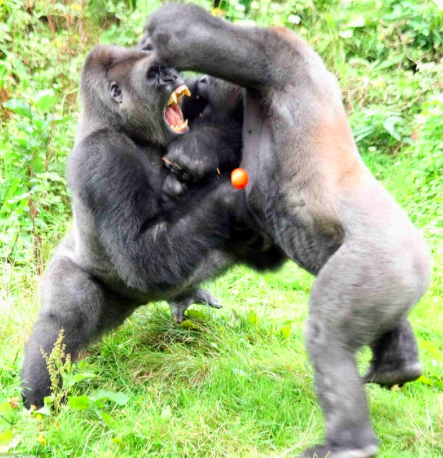Most bird and mammal species are highly social. Not surprisingly, the most social clades of animals are also the smartest and have the biggest brains because being social is extra demand on cognitive function. There’s a lot to keep track of. Which members are mates, parents, siblings, friends, rivals, and so on, but also just the basics of social behavior. How to behave properly, courtship, and so on.

Some species engage in even more complex social behaviors. Think about cooperative hunting, predator alarm calls, and prey-predator signaling, those are highly complicated phenomena and require an animal to deeply analyze the world around her and then communicate to conspecifics about that.
Many animals, probably a lot more than we realize, also communicate with one another in a referential way, the hints of the beginning of language. (I’ve written about this in monkeys here, prairie dogs here, and about gestural communication in apes here and here.) The bottom line is that all these social interactions require a lot of brain power. Natural selection would thus favor individuals with bigger and smarter brains that can navigate the social interactions (assuming that there is a benefit to survival and/or reproduction for those who perform well in these social interactions).

Sure enough, many studies have confirmed that, among primates, brain size correlates reasonably well with the typical size of the social group for that species. These studies have had to employ complicated statistics to reveal this correlation because so many other factors also affect brain size, such as overall body size. In addition, one cannot compare very distantly related species when looking for these comparisons because throughout a long evolutionary history, brain size can grow and shrink, the richness of the social interactions can wax and wane, etc. Comparing human brains to kangaroo brains and then drawing conclusions about sociality would be stretching. However, within a given clade of related animals, especially when they share a great many behavioral patterns, it may be valid to consider correlations between sociality and brain size.
A new study in woodpeckers is adding nuance to this correlation. A team led by Richard Byrne at St. Andrew’s University in Scotland conducted a survey of brain size and social living style in 61 species of woodpecker and found almost the opposite phenomenon. In their survey, woodpeckers that live a mostly solitary life (besides the sociality necessary for courtship, nest-building, egg-warming/protecting, and the rearing of infants) have roughly the same brain size as those that live in stable pair-bonds throughout the year. The additional sociality of pair-bonding versus solitary life has not seemed to lead to bigger brain brains.

Even stranger, woodpeckers that live in stable groups actually have smaller brains than the solitary and pair-bonded woodpeckers. At least in woodpeckers, social living seems to correlate with smaller brains, not bigger ones. The correlation is statiscially significant at p=0.01. This means that there is only a 1% chance that this correlation is purely by chance. (N.B. It does not rule out some other variable that for some reason correlates with both brain size and group-living.)

Does this mean that all of our thoughts about brain size and sociality are wrong? Of course not. One study on one kind of animal does not undermine dozens of studies on other species. But it does force us to think more deeply about sociality and its cognitive demands. Could sociality in woodpeckers and primates be different?
Primate social structure is certainly more complex than that of woodpeckers, but that alone cannot explain these data. If it were just a complexity issue, we would expect less or no correlation, but what we find is that the correlation is flipped. It’s not just that social woodpeckers don’t have bigger brains – their brains are actually a bit smaller.
The most obvious difference in the sociality of woodpeckers and primates is in the balance of cooperation versus competition. Woodpecker sociality is all about cooperation and living together in relative harmony. Like all species, woodpeckers engage in the great struggles of life, but their struggle against each other is minimal, at least in terms of social dynamics. They don’t have a dominance hierarchy; they don’t really compete for food or other resources. They also don’t form complex social alliances. They just don’t need to keep track of any of those things. Their sociality is mostly cooperative.

Not so in primates. Of course, group living involves some cooperation and this cooperation brings benefits or else the loners would go their own way and be better off for it. However, evolution into a strict requirement for social living may be a trap. Once you are locked into a group structure, intra-group competition can emerge and become the dominant social force. Fellow group members are not just cooperators, they are competitors and fierce ones at that. Primate groups are marked by dominance hierarchy and social stratification.
Primates, especially apes, and especially humans, are notoriously competitive, both between groups and within their in-group. Sure, primates will work together when it serves their interests, but if there is a way to get ahead by putting someone else at a disadvantage, things get downright Machiavellian. In certain situations, for example when food resources are not often limiting or cooperative predator lookout is not a major concern, competition between group members can become the most dominant social phenomenon.
In other words, it takes more intelligence to compete than to cooperate. It makes sense when you think about it. For cooperation, we need only to think of what we need in common, what we have in common, and so forth. Empathy – taking the perspective of others – gets you most of the way there. Competition, however, requires you to understand others and then go several steps further. In order to undermine someone, you have to do all the same mental calculations that you would have to do to cooperate with them, and then calculate further to figure out how to use that against them. This can involve violence, trickery, manipulation, deception, sneaky behavior, and so on.

Further still, dominance, violence, and competition often leads to the formation of uneasy alliances so that some group members forgo competition against each other in order to better compete against others as a team. This is very common in apes and humans are no exception. Such conflict-driven alliances involve all the same work as cooperation but in an ultimately competitive context. Thus, the most successful animals will be those that have the brain power for both cooperation and competition and can switch between those two modes at will, which requires further social savvy and also executive reasoning. As I’ve written previously, the tenuous balance between cooperation and competition, was likely a major driving force in the evolution of the human intellect.
When I asked Professor Byrne how he came to do this study, he told me, “It had bugged me for years, that the famous correlation between social group size and brain enlargement didn’t apply to birds – I was sure it should!”
But why woodpeckers specifically? Byrne continued, “While birding in South-East Asia, a tropical region where there are many species of woodpecker living sympatrically in the same forests, I realized that here was a group that had the necessary variety to make a fair test: some were solitary, once the pair had finished bringing up the young; others were in pairs year-round, and a few were more social than that, living long-term in stable groups. I was expecting the largest brains in social species, and a bit of an advantage for long-term pair-bonded ones.”
But the opposite turned out to be true. “I could not have been more surprised,” says Byrne.
Lowly woodpeckers may seem like an unlikely source of inspiration for musings about human evolution, but the underlying theme of biological anthropology is that the same selective forces that have shaped other animals have shaped Homo sapiens. The skill of cooperation places a different set of cognitive demands on a species than the skill of cooperation does. The species that masters both, masters all.
-NHL

But human brains have been shrinking since the stone age. How does that play into this narrative?
http://discovermagazine.com/2010/sep/25-modern-humans-smart-why-brain-shrinking
LikeLike
The short answer is that we don’t fully know. But the article you sent runs down the most commonly thought notions about this and the truth is probably some combination of those. Scaling (smaller bodies), domestication, and also efficiency. The Homo genus stands alone in the reorganization of the brain – something we can only crudely measure from endocasts. This likely brought about substantial efficiency and then the selection came down on the side of smaller brains as the body got smaller and the calorie-guzzling brain became a liability. I’m not as keen on the idiocracy theory, though I’ll admit that’s based more on just a feeling. I’m more with Hawks on that one. Also, the nutritional/caloric theory seems to be gaining steam in the field, though, again, that’s just a feeling. Ultimately, we have the problem of analyzing what is going on with brain WITHIN a lineage (ours) and comparing that to correlations we see BETWEEN lineages (which is what this blog post is about). The reasoning for one of those questions doesn’t always apply to the other. But great question – I LOVE these kinds of conversations!
LikeLike
Yeah, thanks Nathan. That distinction of *within* and *between* is important here, but I was really wondering if the same types of snapshots in time found within our own species might explain the findings for the woodpeckers. I believe these shrinking brains have been found for present day dogs compared to wolves, the domesticated foxes in Siberia, and domesticated sheep too. In light of that, perhaps these data from the woodpecker don’t seem so out of place. Maybe one woodpecker is simply in the process of domesticating itself (or undergoing one of the other hypotheses in the article I shared) compared to the other species of woodpecker?
(By the way, I love these conversations too! I found your site after my Evolutionary Philosophy blog was also named one of the Top 100 Philosophy Blogs and I took a look through the rest of the list. I’m at http://www.evphil.com where I try to work out a philosophical worldview consistent with the findings of evolutionary history. Your kind of expertise is very helpful to me so thanks for sharing it freely.)
LikeLike
You bet! Such interesting question with such big implications. I look forward to reading more of your thoughts as well. Domestication is a process that fascinates me as well. I haven’t had occasion to write much about it, but I’ll have to put that on my list.
LikeLiked by 1 person